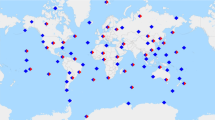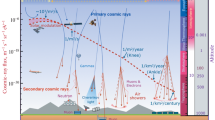Abstract
Several efforts have been made in the Comprehensive Nuclear-Test-Ban Treaty (CTBT) community to assess the benefits of combining detections of radionuclides to improve the location estimates available from atmospheric transport modeling (ATM) backtrack calculations. We present a Bayesian estimation approach rather than a simple dilution field of regard approach to allow xenon detections and non-detections to be combined mathematically. This system represents one possible probabilistic approach to radionuclide event formation. Application of this method to a recent interesting radionuclide event shows a substantial reduction in the location uncertainty of that event.



Similar content being viewed by others
References
CTBTO (2014) Verification Regime. http://www.ctbto.org/verification-regime/monitoring-technologies-how-they-work/radionuclide-monitoring/page-5/. Accessed 13 Oct 2014
Bowyer TW, Schlosser C, Abel KH, Auer M, Hayes JC, Heimbigner TR, McIntyre JI, Panisko ME, Reeder PL, Satorius H, Schulze J, Weiss W (2002) Detection and analysis of xenon isotopes for the comprehensive nuclear-test-ban treaty international monitoring system. J Environ Radioact 59(2):139–151. doi:10.1016/s0265-931x(01)00042-x
Kalinowski M, Axelsson A, Bean M, Blanchard X, Bowyer T, Brachet G, Hebel S, McIntyre J, Peters J, Pistner C, Raith M, Ringbom A, Saey P, Schlosser C, Stocki T, Taffary T, Kurt Ungar R (2010) Discrimination of nuclear explosions against civilian sources based on atmospheric xenon isotopic activity ratios. Pure Appl Geophys 167(4):517–539. doi:10.1007/s00024-009-0032-1
Keats A, Yee E, Lien F-S (2007) Bayesian inference for source determination with applications to a complex urban environment. Atmos Environ 41(3):465–479. doi:10.1016/j.atmosenv.2006.08.044
Rao KS (2007) Source estimation methods for atmospheric dispersion. Atmos Environ 41(33):6964–6973. doi:10.1016/j.atmosenv.2007.04.064
Eslinger PW, Biegalski SR, Bowyer TW, Cooper MW, Haas DA, Hayes JC, Hoffman I, Korpach E, Yi J, Miley HS, Rishel JP, Ungar K, White B, Woods VT (2014) Source term estimation of radioxenon released from the Fukushima Dai-ichi nuclear reactors using measured air concentrations and atmospheric transport modeling. J Environ Radioact 127(1):127–132. doi:10.1016/j.jenvrad.2013.10.013
Eslinger PW, Friese JI, Lowrey JD, McIntyre JI, Miley HS, Schrom BT (2014) Estimates of radioxenon released from Southern Hemisphere medical isotope production facilities using measured air concentrations and atmospheric transport modeling. J Environ Radioact 135(2014):94–99. doi:10.1016/j.jenvrad.2014.04.006
Delle Monache L, Lundquist JK, Kosović B, Johannesson G, Dyer KM, Aines RD, Chow FK, Belles RD, Hanley WG, Larsen SC, Loosmore GA, Nitao JJ, Sugiyama GA, Vogt PJ (2008) Bayesian inference and Markov chain Monte Carlo sampling to reconstruct a contaminant source on a continental scale. J Appl Meteorol Climatol 47(10):2600–2613. doi:10.1175/2008jamc1766.1
Yee E (2012) Inverse dispersion for an unknown number of sources: model selection and uncertainty analysis. ISRN Appl Math 2012:20. doi:10.5402/2012/465320
Wade D, Senocak I (2013) Stochastic reconstruction of multiple source atmospheric contaminant dispersion events. Atmos Environ 74:45–51. doi:10.1016/j.atmosenv.2013.02.051
Dellaportas P, Forster J, Ntzoufras I (2002) On Bayesian model and variable selection using MCMC. Stat Comput 12(1):27–36. doi:10.1023/a:1013164120801
Brooks SP (1998) Markov chain Monte Carlo method and its application. J R Stat Soc Ser D (The Statistician) 47(1):69–100
Draxler RR, Stunder B, Rolph G, Stein A, Taylor A (2013) HYSPLIT4 User’s Guide, Version 4. Air Resources Laboratory, National Oceanic and Atmospheric Administration (NOAA), Silver Spring, Maryland
Draxler RR, Hess GD (1997) Description of the HYSPLIT_4 modeling system. NOAA Air Resources Laboratory, Silver Spring, Maryland
Ringbom A, Axelsson A, Aldener M, Auer M, Bowyer TW, Fritioff T, Hoffman I, Khrustalev K, Nikkinen M, Popov V, Popov Y, Ungar K, Wotawa G (2014) Radioxenon detections in the CTBT international monitoring system likely related to the announced nuclear test in North Korea on February 12, 2013. J Environ Radioact 128:47–63. doi:10.1016/j.jenvrad.2013.10.027
Saey PRJ (2009) The influence of radiopharmaceutical isotope production on the global radioxenon background. J Environ Radioact 100(5):396–406. doi:10.1016/j.jenvrad.2009.01.004
Draxler RR, Hess GD (1998) An overview of the HYSPLIT_4 modeling system of trajectories, dispersion, and deposition. Aust Meteorol Mag 47:295–308
EDAS (2015) Downloadable North American Data Assimilation System 40 km meteorological data set archive. Air Resources Laboratory, National Oceanic and Atmospheric Administration. http://arlftp.arlhq.noaa.gov/pub/archives/edas40/. Accessed 15 Jan 2015
Hayes JC, Ely JH, Haas DA, Harper WW, Heimbigner TR, Hubbard CW, Humble PH, Madison JC, Morris SJ, Panisko ME, Ripplinger MD, Stewart TL (2013) Requirements for Xenon International. Pacific Northwest National Laboratory, Richland. doi:10.2172/1122330
Ringbom A, Larson T, Axelsson A, Elmgren K, Johansson C (2003) SAUNA—a system for automatic sampling, processing, and analysis of radioactive xenon. Nucl Instrum Methods Phys Res Sect A 508(3):542–553. doi:10.1016/s0168-9002(03)01657-7
Fontaine JP, Pointurier F, Blanchard X, Taffary T (2004) Atmospheric xenon radioactive isotope monitoring. J Environ Radioact 72(1–2):129–135. doi:10.1016/S0265-931X(03)00194-2
Zhang M, Wen L (2013) High-precision location and yield of North Korea’s 2013 nuclear test. Geophys Res Lett 40(12):2941–2946. doi:10.1002/grl.50607
GHDA (2012) Downloadable half-degree global data assimilation system information archive. Air Resources Laboratory, National Oceanic and Atmospheric Administration. http://arlftp.arlhq.noaa.gov/pub/archives/gdas0p5/. Accessed 25 April 2012
Saey PRJ, Bowyer TW, Ringbom A (2010) Isotopic noble gas signatures released from medical isotope production facilities—simulations and measurements. Appl Radiat Isot 68(9):1846–1854. doi:10.1016/j.apradiso.2010.04.014
Acknowledgments
The authors also wish to acknowledge the funding support of the U.S. Department of State and the Defense Threat Reduction Agency.
Author information
Authors and Affiliations
Corresponding author
Rights and permissions
About this article
Cite this article
Eslinger, P.W., Schrom, B.T. Multi-detection events, probability density functions, and reduced location area. J Radioanal Nucl Chem 307, 1599–1605 (2016). https://doi.org/10.1007/s10967-015-4339-3
Received:
Published:
Issue Date:
DOI: https://doi.org/10.1007/s10967-015-4339-3




